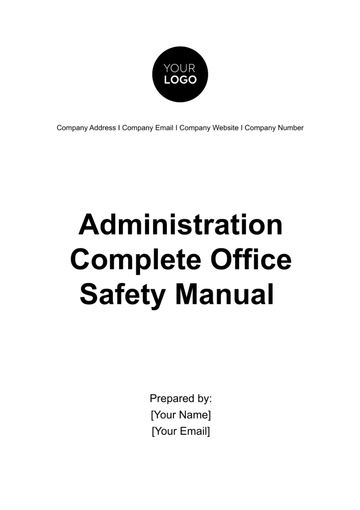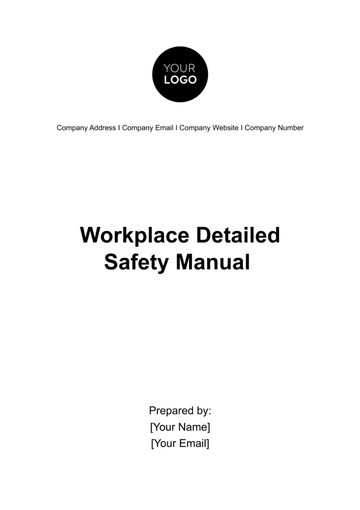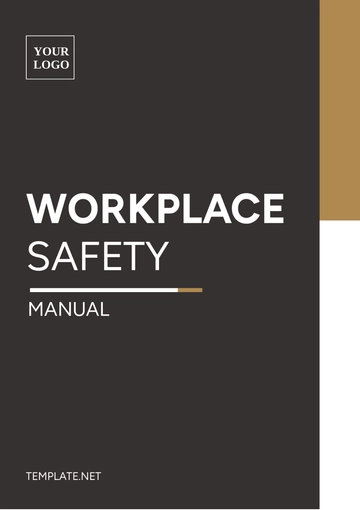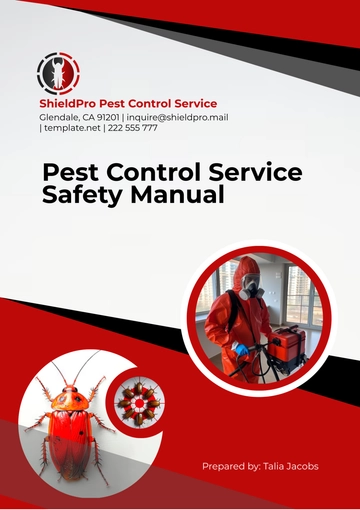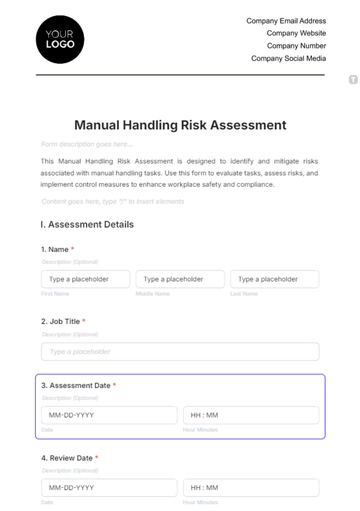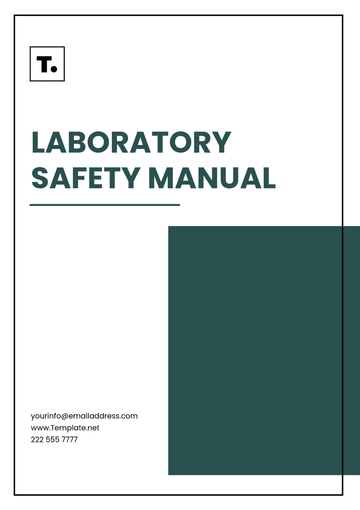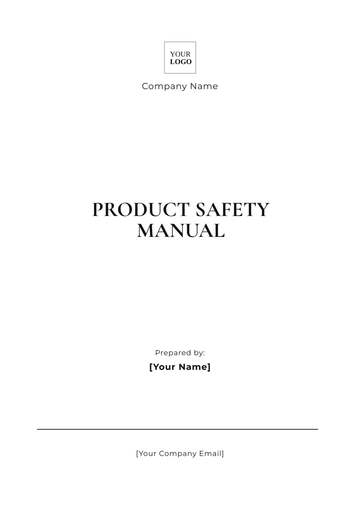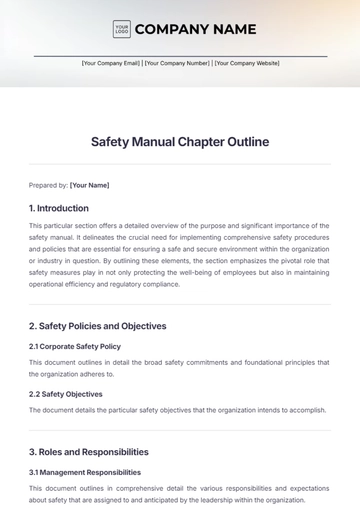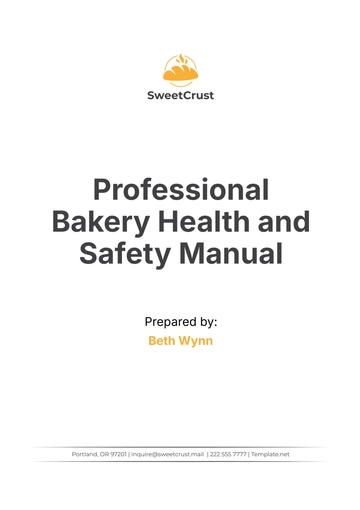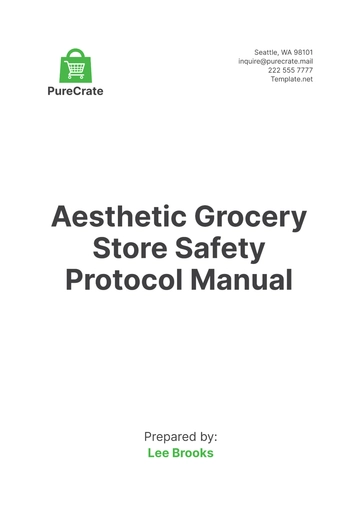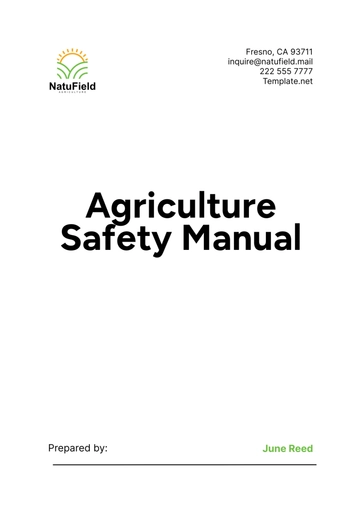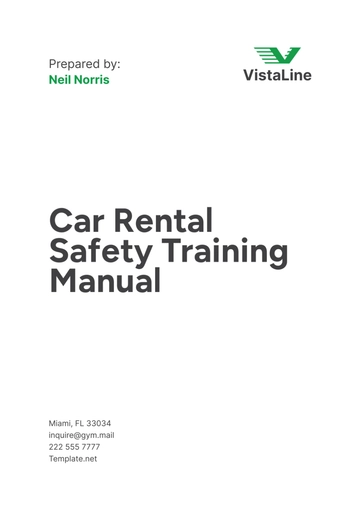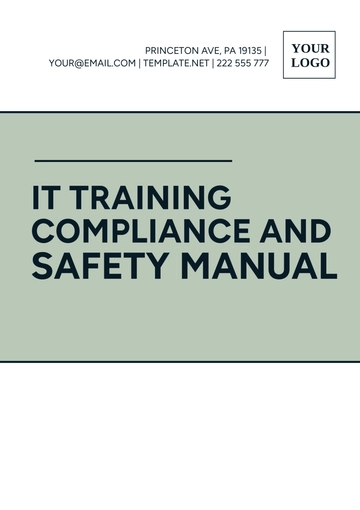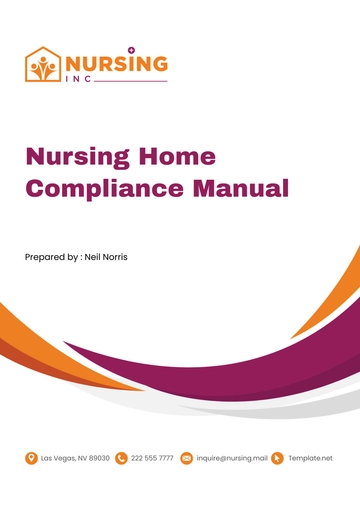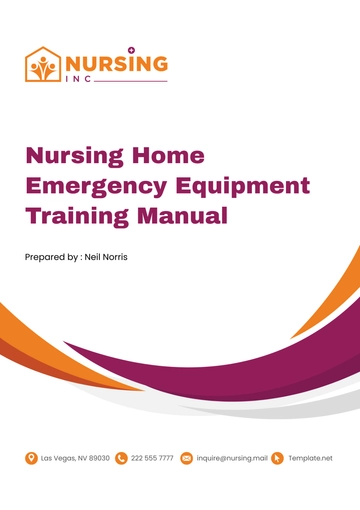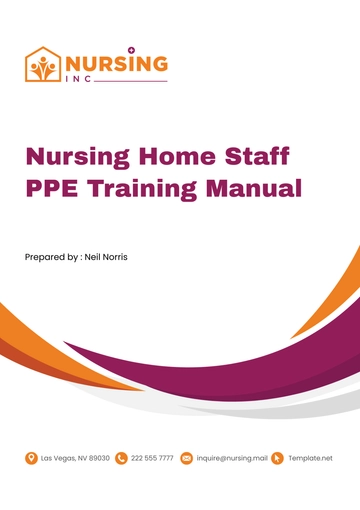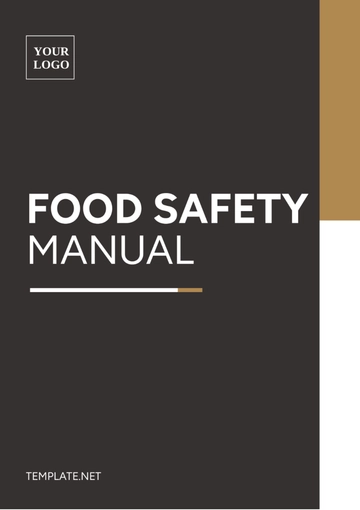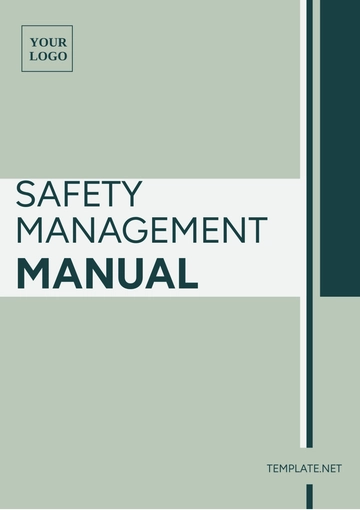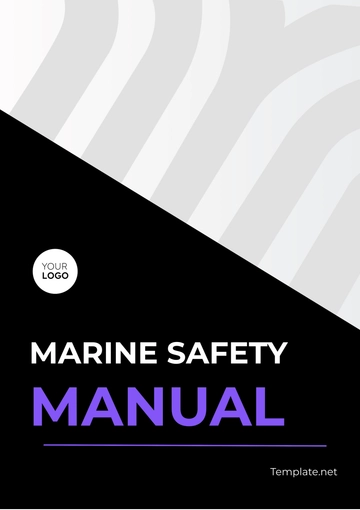Free Health & Safety Detailed Committee Manual
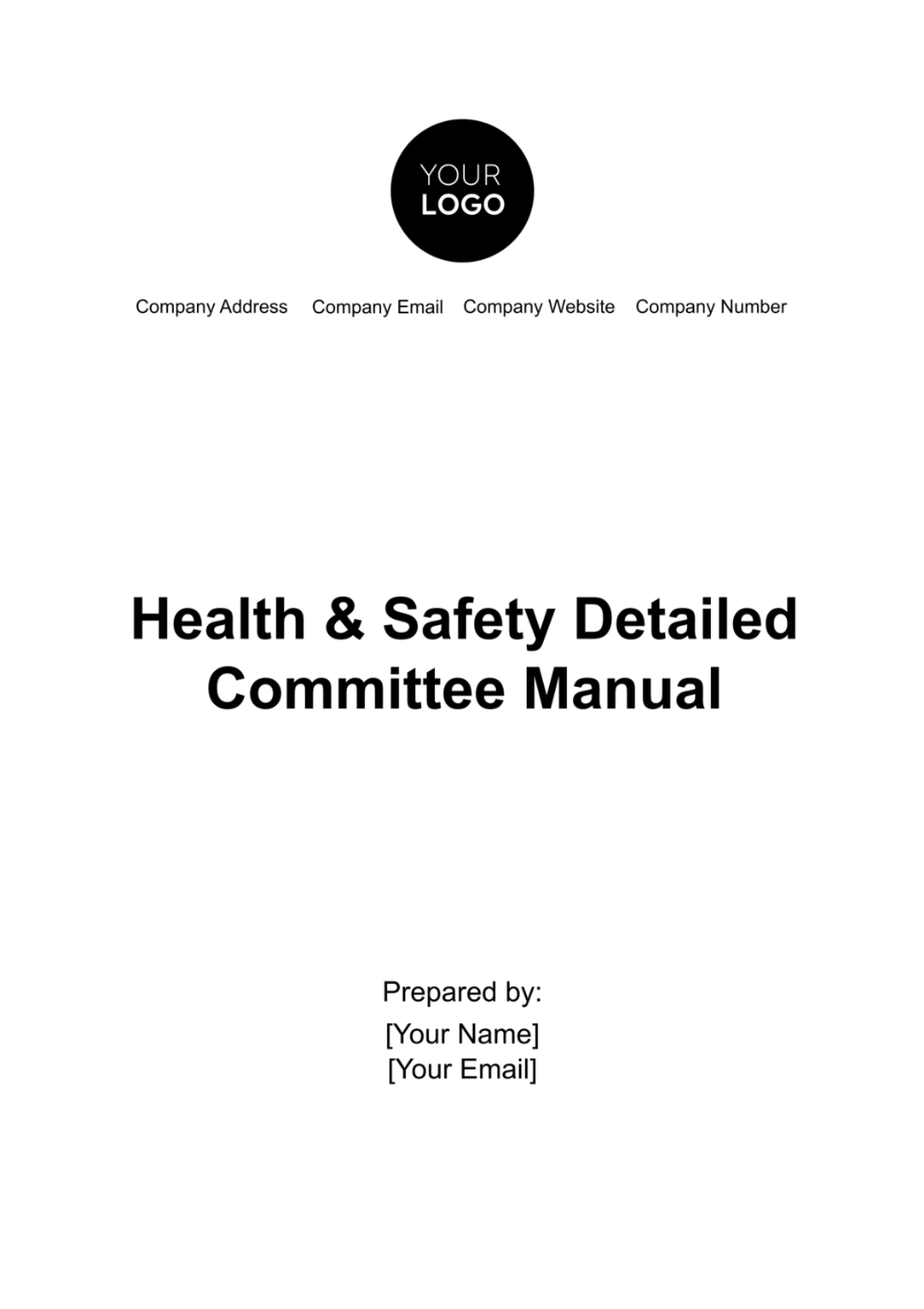
Introduction
Welcome to the Health & Safety Committee Formation and Management Manual. This manual serves as a comprehensive guide for establishing and managing an effective Health & Safety Committee within your organization. The primary goal of this manual is to ensure that workplace safety is a paramount concern and is systematically addressed through the formation and operation of a dedicated committee.
Section 2: Formation of the Committee
Criteria for Committee Membership
The Health & Safety Committee shall consist of members who demonstrate a strong commitment to workplace safety and possess relevant knowledge or experience.
The table below outlines the ideal criteria for committee membership:
Member Role | Qualifications | Responsibilities |
Chairperson | Senior management position, thorough understanding of organizational safety policies | Oversee committee operations, liaison with management, set meeting agendas |
Secretary | Organizational skills, experience in documentation | Record meeting minutes, manage documentation, circulate information |
Safety Officer | Professional safety certification, experience in risk assessment | Lead risk assessments, advise on safety procedures, training facilitation |
Employee Representative | Employed for at least 1 year, nominated by peers | Represent employee safety concerns, participate in discussions |
Health Advisor | Background in occupational health or medicine | Provide health-related insights, assist in health policy development |
Selection Process
The selection of Health & Safety Committee members is a critical step to ensure a balanced and effective team. Members are selected through a transparent process:
Chairperson and Secretary: Appointed by senior management based on their qualifications and experience.
Safety Officer: Chosen from among the organization's safety professionals through an internal job posting and interview process.
Employee Representative: Elected by the employees through an anonymous voting process conducted every two years.
Health Advisor: Appointed by the management, often from the organization's health and wellness team or external consultants.
Section 3: Committee Structure
Organizational Hierarchy
The committee is structured to facilitate clear communication and efficient decision-making. The hierarchy is as follows:
Chairperson: Leads the committee and ensures that all activities align with organizational goals.
Secretary: Supports the chairperson in administrative tasks and manages records.
Subcommittees: Depending on the size of the organization, subcommittees may be formed to address specific safety areas such as emergency response, training, or workplace ergonomics.
Roles and Responsibilities
Each committee member has distinct roles and responsibilities, as detailed in the table below:
Position | Responsibilities |
Chairperson | Sets meeting agendas, leads discussions, represents the committee in management meetings. |
Secretary | Records minutes, maintains documentation, communicates meeting outcomes. |
Safety Officer | Conducts risk assessments, recommends safety improvements, monitors compliance with safety regulations. |
Employee Representative | Brings forward employee concerns, participates in policy development, helps in disseminating information to staff. |
Health Advisor | Provides medical and health-related advice, assists in developing health policies, reviews health trends within the organization. |
Section 4: Meetings and Procedures
Meeting Frequency and Scheduling
The Health & Safety Committee will convene monthly, with additional meetings scheduled as required by emerging safety issues or incidents. Meetings are typically held on the first Wednesday of each month at 10:00 AM. Special meetings can be called by the Chairperson or at the request of any two committee members.
Emergency meetings are convened within 24 hours in response to serious incidents or urgent safety concerns.
Agenda Setting and Documentation
Preparing the Agenda
The Chairperson, in consultation with the Secretary, prepares the meeting agenda at least one week in advance.
Committee members may submit items for the agenda to the Secretary three days before the meeting.
The agenda includes a review of the previous meeting’s minutes, discussion of ongoing safety issues, new business, and action items for the next meeting.
Meeting Documentation
The Secretary is responsible for recording detailed minutes of each meeting.
Minutes include attendance, discussions, decisions made, and assigned action items.
Meeting minutes are distributed to all members within three days post-meeting for review and approval at the next meeting.
Section 5: Health & Safety Policies
Development of Safety Policies
The committee plays a pivotal role in developing and reviewing safety policies. This process involves:
Identifying areas where new policies are needed or existing ones require updating.
Researching best practices and regulatory requirements related to workplace safety.
Drafting policy documents and circulating them among committee members for input and feedback.
Finalizing policies after incorporating suggestions and presenting them to management for approval.
Implementation and Monitoring
The table below outlines the steps for policy implementation and monitoring:
Step | Description |
Policy Communication | Disseminating new or updated policies to all employees through emails, meetings, and training sessions. |
Implementation | Ensuring that all employees understand and comply with the policies. This may include training sessions or demonstrations. |
Monitoring and Enforcement | Regularly checking compliance through inspections, audits, and feedback from staff. |
Review and Update | Annually reviewing policies to ensure they remain relevant and effective. Making updates as necessary based on new regulations, technology, or workplace changes. |
Section 6: Risk Assessment and Management
The Health & Safety Committee plays a crucial role in identifying, assessing, and managing workplace risks to ensure a safe working environment for all employees.
Identifying and Assessing Risks
1. Risk Identification Process
The committee conducts quarterly walk-throughs of the workplace to identify potential hazards.
Employees are encouraged to report hazards or safety concerns through a dedicated safety portal or directly to the Safety Officer.
External safety audits are conducted annually to identify risks that might be overlooked internally.
2. Risk Assessment Methodology
Upon identifying a potential hazard, the Safety Officer leads a risk assessment using the following criteria:
Likelihood of occurrence
Potential severity of harm
Number of employees affected
The assessment results are categorized into 'Low', 'Medium', or 'High' risk.
Risk Mitigation Strategies
The following table outlines common workplace risks identified and corresponding mitigation strategies:
Identified Risk | Risk Level | Mitigation Strategy |
Slippery floors in production area | High | Implementing anti-slip floor coatings, providing non-slip footwear, and displaying warning signage. |
Inadequate emergency exits | High | Reevaluating exit routes, removing obstructions, and conducting regular emergency drills. |
Exposure to hazardous chemicals | Medium | Providing proper personal protective equipment, training on handling procedures, and improving ventilation. |
Repetitive motion injuries in assembly line | Low | Introducing ergonomic tools, scheduling regular breaks, and providing training on proper body mechanics. |
Monitoring and Review
The effectiveness of mitigation strategies is monitored through monthly safety inspections and employee feedback.
The committee reviews the effectiveness of each strategy semi-annually and makes adjustments as necessary.
Section 7: Training and Awareness Programs
The Health & Safety Committee is responsible for ensuring that all employees are well-trained in safety practices and are aware of the importance of maintaining a safe working environment.
Training Programs for Employees
Development of Training Programs
The committee collaborates with external safety experts to develop comprehensive training programs.
Training topics include general workplace safety, emergency response procedures, specific equipment handling, and first aid.
Training is tailored to different departments, considering the unique risks and safety requirements of each area.
Execution of Training
All new employees undergo a mandatory safety orientation session within their first week.
Regular training sessions are scheduled quarterly, and attendance is mandatory for all employees.
Refresher courses and additional training sessions are conducted whenever new equipment or processes are introduced.
Evaluation of Training Effectiveness
Post-training evaluations are conducted to assess the effectiveness of the training and gather employee feedback.
The committee reviews these evaluations to continuously improve training content and delivery methods.
Promoting Safety Awareness
Safety Communication
Monthly safety newsletters are circulated, highlighting safety tips, recent incidents, and lessons learned.
Safety posters and signage are prominently displayed throughout the workplace to remind employees of key safety practices.
Safety Campaigns
Annual safety campaigns are organized, featuring activities like safety quizzes, workshops, and guest speakers to engage employees and promote safety awareness.
Recognition programs are implemented to reward departments or individuals who demonstrate exemplary safety practices.
Employee Involvement
Employees are encouraged to participate in safety committees or become safety champions within their departments.
Suggestions for improving workplace safety are solicited from all employees, and those contributing valuable ideas are acknowledged.
Conclusion
Summary of Committee's Role
The Health & Safety Committee plays a crucial role in maintaining a safe and healthy work environment. Through its structured approach to risk management, policy development, training, and employee engagement, the committee helps to minimize workplace hazards and promote a culture of safety. The effectiveness of the committee is contingent upon the active participation, commitment, and collaboration of all its members.
The Path Forward
As workplace environments continue to evolve, so do the challenges related to health and safety. It is imperative that the Health & Safety Committee remains vigilant, adaptable, and responsive to new safety concerns and regulations. Continuous improvement, regular training updates, and open communication within the organization are key to sustaining a safe workplace. This manual should be regarded as a living document, subject to review and revision as necessary, to reflect the changing needs and circumstances of the organization.
- 100% Customizable, free editor
- Access 1 Million+ Templates, photo’s & graphics
- Download or share as a template
- Click and replace photos, graphics, text, backgrounds
- Resize, crop, AI write & more
- Access advanced editor
Unveil Template.net's Health & Safety Detailed Committee Manual Template. It's entirely editable and customizable, tailored to suit your organization's specific requirements. Utilize our intuitive Ai Editor Tool to streamline the process, ensuring your safety protocols are comprehensive and effective. Elevate workplace safety standards with Template.net's versatile solution.

